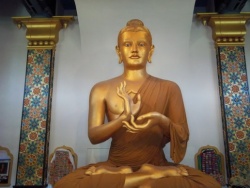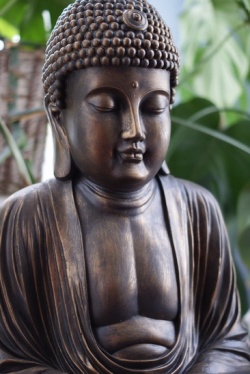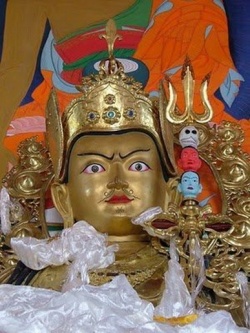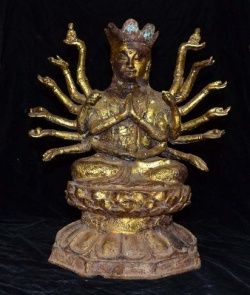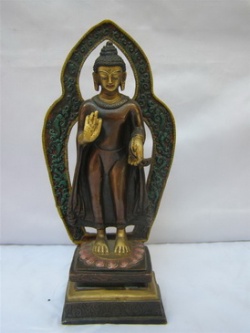Difference between revisions of "Sanskrit and Chinese"
| Line 1: | Line 1: | ||
[[File:626-1000.jpg|thumb|250px|]] | [[File:626-1000.jpg|thumb|250px|]] | ||
<poem> | <poem> | ||
| − | |||
| − | |||
| − | |||
| − | + | After some years of studying pre-modern [[forms]] of written {{Wiki|Chinese}} I took a serious look at [[Sanskrit]]. After studying the [[latter]] {{Wiki|ancient}} [[Language]] I discovered that the former lacked any sort of systematized [[grammar]]. [[Wikipedia:Edwin G. Pulleyblank|Edwin G. Pulleyblank]] in the preface of his famous Outline of Classical {{Wiki|Chinese}} makes the following remarks about the slow beginnings in the systematic study of classical [[forms]] of {{Wiki|Chinese}}: | |
| − | Here a {{Wiki|distinction}} needs to be made between [[Classical Chinese]] [[古文]] and [[Literary Chinese]] [[文言文]]. The former should be regarded as a spoken [[Language]] which was written down. In [[reality]] it is a very broad category encompassing everything from the [[Shang]] Dynasty (1600 - 1046 BCE) to the early {{Wiki|Han Dynasty}} (206 BCE - 220 CE). It would include texts like the [[Analects of Confucius]] [[論語]] and the even older [[Book of Poems]] [[詩經]], which even in {{Wiki|Confucius}}' [[time]] was already quite aged. There are actually a number of {{Wiki|dialects}} in Classical {{Wiki|Chinese}} which of course reflect the numerous actual spoken {{Wiki|dialects}} in [[existence]] at the [[time]]. For example, the [[Analects of Confucius]] [[論語]] and [[Menicus]] [[孟子]] were composed in the [[dialec of the kingdom]] of [[Lu]] [[魯]], while [[Hanfeizi]] [[韓非子]] and the [[Book of Lord Shang]] [[商君書]] were of the [[Qin]] {{Wiki|dialect}} [[秦]] {{Wiki|dialect}}. | + | The [[World]] has, of course, changed greatly in the half century since I began to study {{Wiki|Chinese}}, not least in {{Wiki|linguistic}} {{Wiki|theory}}, which has been revolutionized by theories of [[Noam Chomsky]] and his followers. While that has |
| + | |||
| + | inspired much recent work on {{Wiki|Modern}} {{Wiki|Chinese}} [[grammar]], it has, unfortunately, had comparatively little impact so far on the study of the classical [[Language]]. We are still at the stage of struggling to work out the basic patterns of Classical {{Wiki|Chinese}} syntax.1 | ||
| + | |||
| + | |||
| + | In the case of [[Sanskrit]] such work was already successfully undertaken and mastered in {{Wiki|ancient}} times by grammarians like [[Pāṇini]]. The [[Sanskrit]] textbooks of today have a standardized and consistent [[grammar]] which has its [[roots]] in very | ||
| + | |||
| + | {{Wiki|ancient Indian}} {{Wiki|history}}. This is unlike {{Wiki|Literary}} and Classical {{Wiki|Chinese}} where while pre-modern [[character]] dictionaries explored the {{Wiki|etymology}} of words, there was no prescribed [[grammar]] on the scale of what the | ||
| + | |||
| + | {{Wiki|Indians}} produced, yet still {{Wiki|Literary}} {{Wiki|Chinese}} was an intelligible and widespread written [[Language]] in use for around two-thousand years. I asked one of my professors if the {{Wiki|Chinese}} ever drafted a prescribed [[grammar]] like | ||
| + | |||
| + | [[Pāṇini]] did in [[India]]. He said that they did not. How was it then that an author in pre-modern times learnt how to write correct {{Wiki|Literary}} {{Wiki|Chinese}}? He suggested it was really a [[matter]] of memorizing a set of standard classical texts and | ||
| + | |||
| + | absorbing the {{Wiki|grammatical}} conventions contained within. As {{Wiki|history}} shows the [[methods]] actually worked. If writers all had a basis in the same {{Wiki|literature}}, then it can be expected that they would be on the same page when it came to what | ||
| + | |||
| + | |||
| + | constituted correct [[grammar]], even if it was based on an {{Wiki|instinct}} developed through organic [[absorption]] of the patterns within a set of {{Wiki|canonical}} texts. | ||
| + | |||
| + | |||
| + | That {{Wiki|being}} said, {{Wiki|East Asian}} {{Wiki|civilization}} did have [[contact]] with [[Indian]] {{Wiki|civilization}} and there were at least a few {{Wiki|individuals}} who were exposed to the systematic [[Indian]] [[understanding]] of [[grammar]], though such | ||
| + | |||
| + | [[influences]] were perhaps not so great. Here I would like to briefly explore two things. I will examine how while {{Wiki|Chinese}} {{Wiki|linguistic}} [[tradition]] touched on areas of {{Wiki|etymology}} and phonetics, they did it without use of {{Wiki|grammatical}} | ||
| + | |||
| + | terms. I would also like to take a look at some of the cases where [[Indian]] {{Wiki|grammatical}} [[ideas]] were adopted in [[China]] and where there were [[influences]] from the study of [[Sanskrit]] on classical {{Wiki|Chinese}} {{Wiki|linguistics}}. | ||
| + | |||
| + | |||
| + | Here a {{Wiki|distinction}} needs to be made between [[Classical Chinese]] [[古文]] and [[Literary Chinese]] [[文言文]]. The former should be regarded as a spoken [[Language]] which was written down. In [[reality]] it is a very broad category encompassing everything | ||
| + | |||
| + | from the [[Shang]] [[Dynasty]] (1600 - 1046 BCE) to the early {{Wiki|Han Dynasty}} (206 BCE - 220 CE). It would include texts like the [[Analects of Confucius]] [[論語]] and the even older [[Book of Poems]] [[詩經]], which even in {{Wiki|Confucius}}' [[time]] was already | ||
| + | |||
| + | quite aged. There are actually a number of {{Wiki|dialects}} in Classical {{Wiki|Chinese}} which of course reflect the numerous actual spoken {{Wiki|dialects}} in [[existence]] at the [[time]]. For example, the [[Analects of Confucius]] [[論語]] and [[Menicus]] [[孟子]] | ||
| + | |||
| + | were composed in the [[dialec of the kingdom]] of [[Lu]] [[魯]], while [[Hanfeizi]] [[韓非子]] and the [[Book of Lord Shang]] [[商君書]] | ||
| + | |||
| + | were of the [[Qin]] {{Wiki|dialect}} [[秦]] {{Wiki|dialect}}. | ||
[[File:6404598.jpg|thumb|250px|]] | [[File:6404598.jpg|thumb|250px|]] | ||
| − | |||
| − | {{Wiki|Ancient}} {{Wiki|Chinese}} {{Wiki|linguistics}} did indeed include areas such as {{Wiki|etymology}}, phonetics and epigraphy, but [[grammar]] itself as it was developed and understood in the Hellenic and [[Indic]] [[worlds]] where prescriptive [[grammar]] was extensively discussed and formulated, is not to be found in classical [[tradition]] of {{Wiki|linguistics}} in [[China]]. In the case of {{Wiki|Literary}} {{Wiki|Chinese}} the [[reality]] is that there never was a prescriptive [[grammar]], yet despite this over the centuries there was still surprising [[Consistency]] and intelligibility owing to the study and [[memorization]] of a certain set of standard texts – in most cases the [[Five Classics]] [[五經]] – which led to an [[absorption]] of [[grammar]] enabling authors to naturally reproduce consistent patterns. This is of course a simplification of a much more complex [[Phenomenon]], but it stands in stark contrast to the linguists in [[India]] who cultivated and developed an extensive [[tradition]] of systematic {{Wiki|linguistics}}, the most famous {{Wiki|individual}} within it {{Wiki|being}} [[Pāṇini]] who wrote the [[Aṣṭādhyāyī]], a [[grammar]] of [[Sanskrit]] which became the standard by which {{Wiki|future}} authors used as a standard. It seems that the [[traditional]] method of {{Wiki|learning}} {{Wiki|Literary}} {{Wiki|Chinese}} was an osmosis of unidentified {{Wiki|grammatical}} patterns rather than a systematic study of readily identified {{Wiki|grammatical}} patterns. | + | What distinguishes Classical {{Wiki|Chinese}} is that in {{Wiki|general}} it reflects the actual spoken [[Language]] of the authors. In contrast to this, {{Wiki|Literary}} {{Wiki|Chinese}} is a written [[Language]] that is to a large extent, though not entirely, based on |
| + | |||
| + | the vocabulary and patterns of Classical {{Wiki|Chinese}}. From around the {{Wiki|Han Dynasty}} the written [[Language]] became divorced from the spoken [[Language]] and over [[time]] this common written [[Language]] spread across all of {{Wiki|East Asia}}, eventually | ||
| + | |||
| + | |||
| + | {{Wiki|being}} employed by [[Korean]], [[Japanese]] and [[Vietnamese]] writers. In a {{Wiki|future}} entry I will take a look at how non-Chinese authors employed {{Wiki|Literary}} {{Wiki|Chinese}}. | ||
| + | |||
| + | |||
| + | {{Wiki|Ancient}} {{Wiki|Chinese}} {{Wiki|linguistics}} did indeed include areas such as {{Wiki|etymology}}, phonetics and epigraphy, but [[grammar]] itself as it was developed and understood in the [[Hellenic]] and [[Indic]] [[worlds]] where prescriptive [[grammar]] was | ||
| + | |||
| + | extensively discussed and formulated, is not to be found in classical [[tradition]] of {{Wiki|linguistics}} in [[China]]. In the case of {{Wiki|Literary}} {{Wiki|Chinese}} the [[reality]] is that there never was a prescriptive [[grammar]], yet despite this over the | ||
| + | |||
| + | |||
| + | centuries there was still surprising [[Consistency]] and intelligibility owing to the study and [[memorization]] of a certain set of standard texts – in most cases the [[Five Classics]] [[五經]] – which led to an [[absorption]] of [[grammar]] enabling authors to | ||
| + | |||
| + | naturally reproduce consistent patterns. This is of course a simplification of a much more complex [[Phenomenon]], but it stands in stark contrast to the linguists in [[India]] who cultivated and developed an extensive [[tradition]] of systematic {{Wiki|linguistics}}, | ||
| + | |||
| + | |||
| + | the most famous {{Wiki|individual}} within it {{Wiki|being}} [[Pāṇini]] who wrote the [[Aṣṭādhyāyī]], a [[grammar]] of [[Sanskrit]] which became the standard by which {{Wiki|future}} authors used as a standard. It seems that the [[traditional]] method of | ||
| + | |||
| + | {{Wiki|learning}} {{Wiki|Literary}} {{Wiki|Chinese}} was an osmosis of unidentified {{Wiki|grammatical}} patterns rather than a systematic study of readily identified {{Wiki|grammatical}} patterns. | ||
| − | One early prominent example of early studies into {{Wiki|etymology}} is the [[Shuowen Jiezi Dictionary]] [[說文解字]] compiled by [[Xu Shen]] [[許慎]] in 100 CE. [[Xu Shen]] sets out to catalogue the characters of his [[time]] by providing both the [[meaning]] and pronunciation of {{Wiki|individual}} characters as well as his own [[ideas]] on the [[reason]] for the compositional [[elements]] in certain characters. Let us examine one entry: | + | One early prominent example of early studies into {{Wiki|etymology}} is the [[Shuowen Jiezi Dictionary]] [[說文解字]] compiled by [[Xu Shen]] [[許慎]] in 100 CE. [[Xu Shen]] sets out to catalogue the characters of his [[time]] by providing both the [[meaning]] and pronunciation of {{Wiki|individual}} characters as well as his [[own]] [[ideas]] on the [[reason]] for the compositional [[elements]] in certain characters. Let us examine one entry: |
| Line 29: | Line 79: | ||
[[File:6555604.jpg|thumb|250px|]] | [[File:6555604.jpg|thumb|250px|]] | ||
| − | Here the [[character]] [[lùn]] [[論]] is identified as [[meaning]] “[[discourse]]” or “[[debate]]”. It states the pronunciation is derived from the right-hand [[element]] [[lún]] [[侖]]. While both of these points are important, one might, at least from our {{Wiki|present}} day {{Wiki|perspective}}, ask why there is no mention if this is a verb or {{Wiki|noun}}? The {{Wiki|dictionary}} does not provide such categorization of words. There simply is no vocabulary for such things as verbs, nouns, prepositions and so on. Unlike in [[Sanskrit]] where the {{Wiki|distinction}} between nominals and verbs is absolutely key and made clear, there is no attempt in this or other dictionaries from the same period to categorize words in such a fashion. | + | Here the [[character]] [[lùn]] [[論]] is identified as [[meaning]] “[[discourse]]” or “[[debate]]”. It states the pronunciation is derived from the right-hand [[element]] [[lún]] [[侖]]. While both of these points are important, one might, at least from our |
| + | |||
| + | {{Wiki|present}} day {{Wiki|perspective}}, ask why there is no mention if this is a verb or {{Wiki|noun}}? The {{Wiki|dictionary}} does not provide such categorization of words. There simply is no vocabulary for such things as verbs, nouns, prepositions and so on. Unlike | ||
| + | |||
| + | |||
| + | in [[Sanskrit]] where the {{Wiki|distinction}} between nominals and verbs is absolutely key and made clear, there is no attempt in this or other dictionaries from the same period to categorize words in such a fashion. | ||
| + | |||
| + | |||
| + | Now, as I understand it, the {{Wiki|modern}} {{Wiki|Chinese}} [[word]] for “verb” [[dòngcí]] [[動詞]] is a borrowing from the [[Japanese]] who crafted this appellation as a result of their encounter with {{Wiki|western}} {{Wiki|linguistics}}. Interestingly the earliest and only reference to the alternative [[word]] for "verb", [[dòngzì]] [[動字]], found in the {{Wiki|modern}} [[Hanyu Dacidian]] | ||
| + | |||
| + | [[漢語大詞典]] comes from [[Ma Jianzhong's]] (1845 – 1900) [[馬建忠]] textbook on {{Wiki|Chinese}} [[grammar]] (published 1898), the first written by a {{Wiki|Chinese}} (the earlier ones having been composed by foreigners), which was based on [[ideas]] from {{Wiki|Latin}} grammar.2 | ||
| − | |||
| + | Long before {{Wiki|Chinese}} intellectuals ever knew of {{Wiki|Latin}} [[grammar]], there was exposure to a similar [[tradition]] from the neighbouring {{Wiki|civilization}} of [[India]]. Now, to what extent was {{Wiki|Chinese}} {{Wiki|linguistics}} influenced by its | ||
| − | + | [[Indian]] counterpart? {{Wiki|Shen Kuo}} [[Wikipedia:Shen Kuo|沈括]] (1031-1095), an [[Intellectual]] with various interests [[including]] [[Sanskrit]], was {{Wiki|aware}} even in his day of [[Sanskrit]] [[influences]] in {{Wiki|Chinese}} {{Wiki|linguistics}}. Consider the following remark from his work [[Dream Pool Essay]] [[夢溪筆談]]. | |
音韻之學,自沈約為四聲,及天竺梵學入中國,其術漸密。 | 音韻之學,自沈約為四聲,及天竺梵學入中國,其術漸密。 | ||
| − | “The methods for the study of phonetics have been refined since [[Shen Yue]] 沈約 [441–513] dealt with the four tones and when [[Indian]] [[Sanskrit]] studies arrived in [[China]].” | + | “The [[methods]] for the study of phonetics have been refined since [[Shen Yue]] [[沈約]] [441–513] dealt with the four tones and when [[Indian]] [[Sanskrit]] studies arrived in [[China]].” |
| Line 46: | Line 106: | ||
[[File:68101 336d.jpg|thumb|250px|]] | [[File:68101 336d.jpg|thumb|250px|]] | ||
| − | [[Beyond]] phonetics what other [[influences]] might there have been? In [[Buddhist]] circles there was an [[understanding]] of [[Sanskrit]] {{Wiki|grammatical}} terms owing to both the study of [[Sanskrit]] itself and the [[existence]] of these terms in {{Wiki|Chinese}} translation. One example of this is the six [[compound]] terms [[六合釋]] ([[Sanskrit]]: [[ṣaṭ-samāsāḥ]]). Let us look at these terms as they are outlined in Charles Muller's Digital {{Wiki|Dictionary}} of [[Buddhism]]: | + | [[Beyond]] phonetics what other [[influences]] might there have been? In [[Buddhist]] circles there was an [[understanding]] of |
| + | |||
| + | [[Sanskrit]] {{Wiki|grammatical}} terms owing to both the study of [[Sanskrit]] itself and the [[existence]] of these terms in {{Wiki|Chinese}} translation. One example of this is the six [[compound]] terms [[六合釋]] ([[Sanskrit]]: [[ṣaṭ-samāsāḥ]]). Let us look at these terms as they are outlined in Charles Muller's Digital {{Wiki|Dictionary}} of [[Buddhism]]: | ||
| Line 53: | Line 115: | ||
* [[相違釋]], (Skt. [[dvaṃdva]]) — a [[compound]] in which both [[elements]] are {{Wiki|equal}} ('[[mountains]] and [[temples]]'). A term indicating two separate [[ideas]], e.g., [[教觀]] [[teaching]] and [[Meditation]]. | * [[相違釋]], (Skt. [[dvaṃdva]]) — a [[compound]] in which both [[elements]] are {{Wiki|equal}} ('[[mountains]] and [[temples]]'). A term indicating two separate [[ideas]], e.g., [[教觀]] [[teaching]] and [[Meditation]]. | ||
| − | * [[持業釋]], (Skt. [[Karma-dhāraya]]) —a [[compound]] in which the first [[element]] is an {{Wiki|adjective}} or adverb, and the second [[element]] a {{Wiki|noun}} or {{Wiki|adjective}}, respectively 'high mountain,' 'very high'. May also indicate two nouns in apposition, referring to the equality of [[dependence]] of both terms, e.g., 大乘 [[Mahāyāna]], 'great' and '[[vehicle]]', both equally [[essential]] to [[Mahāyāna]] with its specific [[meaning]]. Also written [[同依釋]]. | + | * [[持業釋]], (Skt. [[Karma-dhāraya]]) —a [[compound]] in which the first [[element]] is an {{Wiki|adjective}} or adverb, and the second [[element]] a {{Wiki|noun}} or {{Wiki|adjective}}, respectively 'high mountain,' 'very high'. May also indicate two nouns in |
| + | |||
| + | apposition, referring to the equality of [[dependence]] of both terms, e.g., [[大乘]] [[Mahāyāna]], 'great' and '[[vehicle]]', both equally [[essential]] to [[Mahāyāna]] with its specific [[meaning]]. Also written [[同依釋]]. | ||
* [[帶數釋]], (Skt. [[dvigu]]) —a [[compound]] in which the first [[element]] is a numeral; 'five [[dharmas]]', '[[Five Skandhas]]' [[五蘊]], etc. | * [[帶數釋]], (Skt. [[dvigu]]) —a [[compound]] in which the first [[element]] is a numeral; 'five [[dharmas]]', '[[Five Skandhas]]' [[五蘊]], etc. | ||
| Line 62: | Line 126: | ||
[[File:6828.jpg|thumb|250px|]] | [[File:6828.jpg|thumb|250px|]] | ||
| − | Judging from when these terms first start appearing in the {{Wiki|Chinese}} [[Tripiṭaka]], it seems it was the great [[translator]] [[Xuanzang]] [[玄奘]] (602-664) who first translated and introduced these terms into {{Wiki|Chinese}}. A few decades later [[Fazang]] [[法藏]] (643–712) was making use of these terms in interpreting {{Wiki|Chinese}} lexical items and many more commentators who likewise made use of them were to follow. | + | Judging from when these terms first start appearing in the {{Wiki|Chinese}} [[Tripiṭaka]], it seems it was the great [[translator]] |
| + | |||
| + | [[Xuanzang]] [[玄奘]] (602-664) who first translated and introduced these terms into {{Wiki|Chinese}}. A few decades later [[Fazang]] [[法藏]] (643–712) was making use of these terms in interpreting {{Wiki|Chinese}} lexical items and many more commentators who likewise made use of them were to follow. | ||
| − | It is also to be noted that in the far {{Wiki|west}} of [[China]] at {{Wiki|Dunhuang}} [[敦煌]], a center for both trade and [[Intellectual]] exchange, there was a cache of texts and paintings sealed in a chamber in 1002 CE and uncovered in the early 20th century. Besides the {{Wiki|Chinese}} texts there were also texts written in numerous [[languages]] including [[Sanskrit]]. This is not surprising considering that to the {{Wiki|west}} in {{Wiki|Central Asia}} in the state of [[Kuci]] [[龜茲]], which was heavily influenced by [[Indian]] {{Wiki|culture}}, [[Monks]] read [[Sanskrit]] and the script was based on an [[Indian]] model with minor changes as [[Xuanzang]] reported.4 Inside the {{Wiki|cave}} the text below, the [[Mahāyāna Mahāparinirvāṇa-mahā Sūtra]], was uncovered. | + | It is also to be noted that in the far {{Wiki|west}} of [[China]] at {{Wiki|Dunhuang}} [[敦煌]], a center for both trade and [[Intellectual]] exchange, there was a cache of texts and paintings sealed in a chamber in 1002 CE and uncovered in the early 20th century. Besides the {{Wiki|Chinese}} texts there were also texts written in numerous [[languages]] [[including]] [[Sanskrit]]. This is not surprising considering that to the {{Wiki|west}} in {{Wiki|Central Asia}} in the [[state]] of [[Kuci]] [[龜茲]], which was heavily influenced by [[Indian]] {{Wiki|culture}}, [[Monks]] read [[Sanskrit]] and the [[script]] was based on an [[Indian]] model with minor changes as [[Xuanzang]] reported.4 Inside the {{Wiki|cave}} the text below, the [[Mahāyāna Mahāparinirvāṇa-mahā Sūtra]], was uncovered. |
Click for larger [[view]]. | Click for larger [[view]]. | ||
| Line 73: | Line 139: | ||
| − | A lot more than this could be written on the [[subjects]] discussed above. However, as this is merely an exploration of the [[subject]] rather than a comprehensive study, I should conclude this blog entry here. The main thing I wanted to point out was that {{Wiki|Literary}} {{Wiki|Chinese}} never had a prescribed [[grammar]] as one would find in Hellenic and [[Indian]] {{Wiki|linguistic}} [[traditions]], and despite that the many authors over the centuries still managed to produce a coherent and functional written [[Language]] that was employed across all of {{Wiki|East Asia}}. I [[imagine]] this was mainly due to the semantics behind {{Wiki|Chinese}} characters. The other relevant observation is that while [[China]] was exposed to [[Sanskrit]] studies and to some extent its {{Wiki|grammatical}} vocabulary, it does not seem to have influenced intellectuals so much [[beyond]] [[Buddhists]] and [[pundit]] characters like {{Wiki|Shen Kuo}}. This is of course based on my own [[opinions]] and observations. If I have made any errors or overlooked anything, I should {{Wiki|hope}} readers will point it out. | + | A lot more than this could be written on the [[subjects]] discussed above. However, as this is merely an exploration of the [[subject]] rather than a comprehensive study, I should conclude this blog entry here. The main thing I wanted to point out was that {{Wiki|Literary}} {{Wiki|Chinese}} never had a prescribed [[grammar]] as one would find in [[Hellenic]] and [[Indian]] {{Wiki|linguistic}} |
| + | |||
| + | [[traditions]], and despite that the many authors over the centuries still managed to produce a coherent and functional written [[Language]] that was employed across all of {{Wiki|East Asia}}. I [[imagine]] this was mainly due to the [[semantics]] behind | ||
| + | |||
| + | {{Wiki|Chinese}} characters. The other relevant observation is that while [[China]] was exposed to [[Sanskrit]] studies and to some extent its {{Wiki|grammatical}} vocabulary, it does not seem to have influenced intellectuals so much [[beyond]] [[Buddhists]] and | ||
| + | |||
| + | [[pundit]] characters like {{Wiki|Shen Kuo}}. This is of course based on my [[own]] [[opinions]] and observations. If I have made any errors | ||
| + | |||
| + | or overlooked anything, I should {{Wiki|hope}} readers will point it out. | ||
[[File:6f03 o.jpg|thumb|250px|]] | [[File:6f03 o.jpg|thumb|250px|]] | ||
| Line 79: | Line 153: | ||
| − | Shuowen Jiezi at {{Wiki|Chinese}} Text Project - Digitalized and searchable edition. | + | [[Shuowen Jiezi]] at {{Wiki|Chinese}} Text Project - Digitalized and searchable edition. |
[[Dream Pool Essays]] [[夢溪筆談]] - Digitalized version of [[Shen Kuo's]] work. For references to [[Sanskrit]] search for the [[character]] fàn [[梵]]. | [[Dream Pool Essays]] [[夢溪筆談]] - Digitalized version of [[Shen Kuo's]] work. For references to [[Sanskrit]] search for the [[character]] fàn [[梵]]. | ||
| Line 85: | Line 159: | ||
{{Wiki|Dunhuang}} Archive - Digital archive of many texts and [[relics]]. | {{Wiki|Dunhuang}} Archive - Digital archive of many texts and [[relics]]. | ||
| − | [[Shuowen Jiezi]] {{Wiki|Dictionary}} and the [[Human]] {{Wiki|Sciences}} in [[China]] by Francoise Bottéro and Christoph Harbsmeier - A good survey of the structure within the Shuowen Jiezi. Article published in {{Wiki|Asian}} Major. | + | [[Shuowen Jiezi]] {{Wiki|Dictionary}} and the [[Human]] {{Wiki|Sciences}} in [[China]] by Francoise Bottéro and Christoph Harbsmeier - A good survey of the {{Wiki|structure}} within the [[Shuowen Jiezi]]. Article published in {{Wiki|Asian}} Major. |
| + | |||
1Pulleyblank, Edwin G., Outline of Classical {{Wiki|Chinese}} [[Grammar]] ({{Wiki|Vancouver}}: UBC, 1995), xiii. | 1Pulleyblank, Edwin G., Outline of Classical {{Wiki|Chinese}} [[Grammar]] ({{Wiki|Vancouver}}: UBC, 1995), xiii. | ||
| − | 2即動詞。 清 馬建忠 《馬氏文通·正名》:“凡實字以言事物之行者,曰動字。” | + | 2即動詞。 [[清]] [[馬建忠]] 《馬氏文通·正名》:“凡實字以言事物之行者,曰動字。” |
3Muller, A. Charles, ed. Digital {{Wiki|Dictionary}} of [[Buddhism]]. . Edition of June 16/2011. | 3Muller, A. Charles, ed. Digital {{Wiki|Dictionary}} of [[Buddhism]]. . Edition of June 16/2011. | ||
4See the following: 《大唐西域記》卷1: 「屈支國,東西千餘里,南北六百餘里。國大都城周十七八里,宜穈、麥,有粳稻,出蒲萄、石榴,多梨、柰、桃、杏。土產黃金、銅、鐵、鉛、錫。氣序和,風俗 質。文字取則印度,粗有改變。管絃伎樂,特善諸國。服飾錦褐,斷髮巾帽。貨用金錢、銀錢、小銅錢。王,屈支種也,智謀寡昧,迫於強臣。其俗生子以木押頭, 欲其遍遞也。伽藍百餘所,僧徒五千餘人,習學小乘教說一切有部。經教律儀,取則印度,其習讀者,即本文矣。尚拘漸教,食雜三淨。潔清耽翫,人以功競。」(CBETA, T51, no. 2087, p. 870, a17-27) | 4See the following: 《大唐西域記》卷1: 「屈支國,東西千餘里,南北六百餘里。國大都城周十七八里,宜穈、麥,有粳稻,出蒲萄、石榴,多梨、柰、桃、杏。土產黃金、銅、鐵、鉛、錫。氣序和,風俗 質。文字取則印度,粗有改變。管絃伎樂,特善諸國。服飾錦褐,斷髮巾帽。貨用金錢、銀錢、小銅錢。王,屈支種也,智謀寡昧,迫於強臣。其俗生子以木押頭, 欲其遍遞也。伽藍百餘所,僧徒五千餘人,習學小乘教說一切有部。經教律儀,取則印度,其習讀者,即本文矣。尚拘漸教,食雜三淨。潔清耽翫,人以功競。」(CBETA, T51, no. 2087, p. 870, a17-27) | ||
| + | |||
| + | |||
| + | |||
</poem> | </poem> | ||
{{R}} | {{R}} | ||
Latest revision as of 20:46, 11 December 2023
After some years of studying pre-modern forms of written Chinese I took a serious look at Sanskrit. After studying the latter ancient Language I discovered that the former lacked any sort of systematized grammar. Edwin G. Pulleyblank in the preface of his famous Outline of Classical Chinese makes the following remarks about the slow beginnings in the systematic study of classical forms of Chinese:
The World has, of course, changed greatly in the half century since I began to study Chinese, not least in linguistic theory, which has been revolutionized by theories of Noam Chomsky and his followers. While that has
inspired much recent work on Modern Chinese grammar, it has, unfortunately, had comparatively little impact so far on the study of the classical Language. We are still at the stage of struggling to work out the basic patterns of Classical Chinese syntax.1
In the case of Sanskrit such work was already successfully undertaken and mastered in ancient times by grammarians like Pāṇini. The Sanskrit textbooks of today have a standardized and consistent grammar which has its roots in very
ancient Indian history. This is unlike Literary and Classical Chinese where while pre-modern character dictionaries explored the etymology of words, there was no prescribed grammar on the scale of what the
Indians produced, yet still Literary Chinese was an intelligible and widespread written Language in use for around two-thousand years. I asked one of my professors if the Chinese ever drafted a prescribed grammar like
Pāṇini did in India. He said that they did not. How was it then that an author in pre-modern times learnt how to write correct Literary Chinese? He suggested it was really a matter of memorizing a set of standard classical texts and
absorbing the grammatical conventions contained within. As history shows the methods actually worked. If writers all had a basis in the same literature, then it can be expected that they would be on the same page when it came to what
constituted correct grammar, even if it was based on an instinct developed through organic absorption of the patterns within a set of canonical texts.
That being said, East Asian civilization did have contact with Indian civilization and there were at least a few individuals who were exposed to the systematic Indian understanding of grammar, though such
influences were perhaps not so great. Here I would like to briefly explore two things. I will examine how while Chinese linguistic tradition touched on areas of etymology and phonetics, they did it without use of grammatical
terms. I would also like to take a look at some of the cases where Indian grammatical ideas were adopted in China and where there were influences from the study of Sanskrit on classical Chinese linguistics.
Here a distinction needs to be made between Classical Chinese 古文 and Literary Chinese 文言文. The former should be regarded as a spoken Language which was written down. In reality it is a very broad category encompassing everything
from the Shang Dynasty (1600 - 1046 BCE) to the early Han Dynasty (206 BCE - 220 CE). It would include texts like the Analects of Confucius 論語 and the even older Book of Poems 詩經, which even in Confucius' time was already
quite aged. There are actually a number of dialects in Classical Chinese which of course reflect the numerous actual spoken dialects in existence at the time. For example, the Analects of Confucius 論語 and Menicus 孟子
were composed in the dialec of the kingdom of Lu 魯, while Hanfeizi 韓非子 and the Book of Lord Shang 商君書
were of the Qin dialect 秦 dialect.
What distinguishes Classical Chinese is that in general it reflects the actual spoken Language of the authors. In contrast to this, Literary Chinese is a written Language that is to a large extent, though not entirely, based on
the vocabulary and patterns of Classical Chinese. From around the Han Dynasty the written Language became divorced from the spoken Language and over time this common written Language spread across all of East Asia, eventually
being employed by Korean, Japanese and Vietnamese writers. In a future entry I will take a look at how non-Chinese authors employed Literary Chinese.
Ancient Chinese linguistics did indeed include areas such as etymology, phonetics and epigraphy, but grammar itself as it was developed and understood in the Hellenic and Indic worlds where prescriptive grammar was
extensively discussed and formulated, is not to be found in classical tradition of linguistics in China. In the case of Literary Chinese the reality is that there never was a prescriptive grammar, yet despite this over the
centuries there was still surprising Consistency and intelligibility owing to the study and memorization of a certain set of standard texts – in most cases the Five Classics 五經 – which led to an absorption of grammar enabling authors to
naturally reproduce consistent patterns. This is of course a simplification of a much more complex Phenomenon, but it stands in stark contrast to the linguists in India who cultivated and developed an extensive tradition of systematic linguistics,
the most famous individual within it being Pāṇini who wrote the Aṣṭādhyāyī, a grammar of Sanskrit which became the standard by which future authors used as a standard. It seems that the traditional method of
learning Literary Chinese was an osmosis of unidentified grammatical patterns rather than a systematic study of readily identified grammatical patterns.
One early prominent example of early studies into etymology is the Shuowen Jiezi Dictionary 說文解字 compiled by Xu Shen 許慎 in 100 CE. Xu Shen sets out to catalogue the characters of his time by providing both the meaning and pronunciation of individual characters as well as his own ideas on the reason for the compositional elements in certain characters. Let us examine one entry:
言部: 論:議也。从言侖聲。
Here the character lùn 論 is identified as meaning “discourse” or “debate”. It states the pronunciation is derived from the right-hand element lún 侖. While both of these points are important, one might, at least from our
present day perspective, ask why there is no mention if this is a verb or noun? The dictionary does not provide such categorization of words. There simply is no vocabulary for such things as verbs, nouns, prepositions and so on. Unlike
in Sanskrit where the distinction between nominals and verbs is absolutely key and made clear, there is no attempt in this or other dictionaries from the same period to categorize words in such a fashion.
Now, as I understand it, the modern Chinese word for “verb” dòngcí 動詞 is a borrowing from the Japanese who crafted this appellation as a result of their encounter with western linguistics. Interestingly the earliest and only reference to the alternative word for "verb", dòngzì 動字, found in the modern Hanyu Dacidian
漢語大詞典 comes from Ma Jianzhong's (1845 – 1900) 馬建忠 textbook on Chinese grammar (published 1898), the first written by a Chinese (the earlier ones having been composed by foreigners), which was based on ideas from Latin grammar.2
Long before Chinese intellectuals ever knew of Latin grammar, there was exposure to a similar tradition from the neighbouring civilization of India. Now, to what extent was Chinese linguistics influenced by its
Indian counterpart? Shen Kuo 沈括 (1031-1095), an Intellectual with various interests including Sanskrit, was aware even in his day of Sanskrit influences in Chinese linguistics. Consider the following remark from his work Dream Pool Essay 夢溪筆談.
音韻之學,自沈約為四聲,及天竺梵學入中國,其術漸密。
“The methods for the study of phonetics have been refined since Shen Yue 沈約 [441–513] dealt with the four tones and when Indian Sanskrit studies arrived in China.”
Shen Kuo makes reference to Sanskrit several times in the aforementioned work. It seems his Interest was concentrated in Sanskrit phonetics which he utilized to further explain aspects of sounds in Chinese.
Beyond phonetics what other influences might there have been? In Buddhist circles there was an understanding of
Sanskrit grammatical terms owing to both the study of Sanskrit itself and the existence of these terms in Chinese translation. One example of this is the six compound terms 六合釋 (Sanskrit: ṣaṭ-samāsāḥ). Let us look at these terms as they are outlined in Charles Muller's Digital Dictionary of Buddhism:
* 依主釋 (Skt. tat-puruṣa) — dependent compound, in which the first noun modifies the second noun ('mountain temple'), or, e.g., 眼識 visual Consciousness, where the eye is the qualifying term. Also written 依士釋.
* 相違釋, (Skt. dvaṃdva) — a compound in which both elements are equal ('mountains and temples'). A term indicating two separate ideas, e.g., 教觀 teaching and Meditation.
* 持業釋, (Skt. Karma-dhāraya) —a compound in which the first element is an adjective or adverb, and the second element a noun or adjective, respectively 'high mountain,' 'very high'. May also indicate two nouns in
apposition, referring to the equality of dependence of both terms, e.g., 大乘 Mahāyāna, 'great' and 'vehicle', both equally essential to Mahāyāna with its specific meaning. Also written 同依釋.
* 帶數釋, (Skt. dvigu) —a compound in which the first element is a numeral; 'five dharmas', 'Five Skandhas' 五蘊, etc.
* An adverbial compound 鄰近釋 (Skt. avyayī-bhāva), or a term resulting from 'neighboring' association, e.g., 念處 Thought or remembering place, i.e., memory. In India, a compound in which the first element is unchangeable; in China, this name is given to a compound in which one of the terms is used in a slightly altered meaning (the 念 in 四念處 should, properly speaking, be 慧 (prajñā), but since 念 (smṛti) resembles 慧 in its function, it is used in place of 慧 in this compound).
* 有財釋,(Skt. bahu-vrīhi) —a compound of two or more elements which is used adjectivally ('black robe' used adjectivally— 'black-robed man'); the sign of possession, e.g., 覺者 he who has Enlightenment. Also written 有財釋 and 多財釋.3
Judging from when these terms first start appearing in the Chinese Tripiṭaka, it seems it was the great translator
Xuanzang 玄奘 (602-664) who first translated and introduced these terms into Chinese. A few decades later Fazang 法藏 (643–712) was making use of these terms in interpreting Chinese lexical items and many more commentators who likewise made use of them were to follow.
It is also to be noted that in the far west of China at Dunhuang 敦煌, a center for both trade and Intellectual exchange, there was a cache of texts and paintings sealed in a chamber in 1002 CE and uncovered in the early 20th century. Besides the Chinese texts there were also texts written in numerous languages including Sanskrit. This is not surprising considering that to the west in Central Asia in the state of Kuci 龜茲, which was heavily influenced by Indian culture, Monks read Sanskrit and the script was based on an Indian model with minor changes as Xuanzang reported.4 Inside the cave the text below, the Mahāyāna Mahāparinirvāṇa-mahā Sūtra, was uncovered.
Click for larger view.
This indeed shows that some individuals were familiar with Sanskrit and its grammatical terms. While these ideas may have had currency within Buddhist circles they were not adopted and employed in any significant way by non-Buddhist literati. It seems the aforementioned terms were really just used as jargon by Buddhist commentators.
A lot more than this could be written on the subjects discussed above. However, as this is merely an exploration of the subject rather than a comprehensive study, I should conclude this blog entry here. The main thing I wanted to point out was that Literary Chinese never had a prescribed grammar as one would find in Hellenic and Indian linguistic
traditions, and despite that the many authors over the centuries still managed to produce a coherent and functional written Language that was employed across all of East Asia. I imagine this was mainly due to the semantics behind
Chinese characters. The other relevant observation is that while China was exposed to Sanskrit studies and to some extent its grammatical vocabulary, it does not seem to have influenced intellectuals so much beyond Buddhists and
pundit characters like Shen Kuo. This is of course based on my own opinions and observations. If I have made any errors
or overlooked anything, I should hope readers will point it out.
Some relevant links:
Shuowen Jiezi at Chinese Text Project - Digitalized and searchable edition.
Dream Pool Essays 夢溪筆談 - Digitalized version of Shen Kuo's work. For references to Sanskrit search for the character fàn 梵.
Dunhuang Archive - Digital archive of many texts and relics.
Shuowen Jiezi Dictionary and the Human Sciences in China by Francoise Bottéro and Christoph Harbsmeier - A good survey of the structure within the Shuowen Jiezi. Article published in Asian Major.
1Pulleyblank, Edwin G., Outline of Classical Chinese Grammar (Vancouver: UBC, 1995), xiii.
2即動詞。 清 馬建忠 《馬氏文通·正名》:“凡實字以言事物之行者,曰動字。”
3Muller, A. Charles, ed. Digital Dictionary of Buddhism. . Edition of June 16/2011.
4See the following: 《大唐西域記》卷1: 「屈支國,東西千餘里,南北六百餘里。國大都城周十七八里,宜穈、麥,有粳稻,出蒲萄、石榴,多梨、柰、桃、杏。土產黃金、銅、鐵、鉛、錫。氣序和,風俗 質。文字取則印度,粗有改變。管絃伎樂,特善諸國。服飾錦褐,斷髮巾帽。貨用金錢、銀錢、小銅錢。王,屈支種也,智謀寡昧,迫於強臣。其俗生子以木押頭, 欲其遍遞也。伽藍百餘所,僧徒五千餘人,習學小乘教說一切有部。經教律儀,取則印度,其習讀者,即本文矣。尚拘漸教,食雜三淨。潔清耽翫,人以功競。」(CBETA, T51, no. 2087, p. 870, a17-27)
